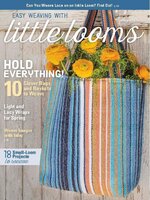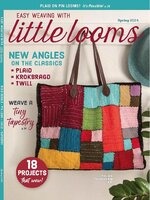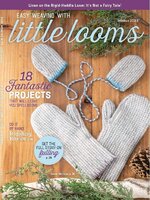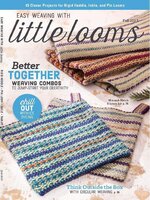Easy Weaving with Little Looms is a perennial favorite. By popular demand, it will now be available by subscription. Each issue will have the mix of 18–22 projects, techniques, and features you love, expanding the focus on fundamental weaving skills, creative inspiration, and innovative applications. Each issue is designed to have something for beginning and more experienced weavers. In addition to the core subjects of rigid-heddle and pin-loom weaving, Little Looms regularly includes projects and articles about tapestry, tablet weaving, and inkle weaving.
EDITORIAL
Little Looms
FANCING FINDINGS • Whether you spend your days off at home in your studio or on vacation, you’ll find these items handy and fun additions to your weaving kit.
PIN LOOM WEAVING TO GO: 30 PROJECTS FOR PORTABLE WEAVING • Pins looms are some of the most portable looms available. With a few exceptions, pin looms easily fit into a standard-sized tote bag, they don’t require much in the way of extra equipment, and they’re easy to pick back up again after hours, days, or even weeks off from weaving a project. For those who want to explore the versatility and portability of pin looms, Margaret Stump’s book Pin Loom Weaving to Go is an excellent resource.
SILK THAT PLAYS WELL WITH OTHERS • Sometimes called the queen of fibers, silk is warm in winter and cool in summer, soft, strong, and light. The enjoyment of weaving with silk is only surpassed by the pleasure of wearing it. Bombyx silk, the product of mulberry leaf–eating Bombyx mori caterpillars, is typically found in three forms: reeled, spun, and noil. Reeled silk is removed from intact cocoons in long filaments by a laborious process, making it the most expensive and most lustrous of the three. Smooth but not quite as lustrous, spun silk is created by carding and spinning some of the remains from reeling and processing the cocoons. The short fibers left over from reeled and spun production processes are spun into noil. Noil has a wonderful texture and retains silk’s warm and soft qualities, but it is missing much of the sheen of reeled and spun silks.
MEET AND SEPARATE • We usually think of handwoven tapestry as weft-faced plain weave and a fabric in which wefts don’t necessarily travel from selvedge to selvedge. In fact, there are often multiple wefts running in each row or pick of a tapestry.
SAMPLING FOR SUCCESS • Designing your own project from start to finish is an exciting, satisfying component of weaving, and is something you are capable of doing well once you understand the fundamentals.
CRAZYSHOT • A few years ago, I dusted off my rigid heddles—safely hidden away from a mischievous pup—and rediscovered my love for weaving on small looms. Something about the rigid-heddle loom in particular gives me a deep sense of satisfaction. I get lost in the repetitive process of shuttling yarn back and forth while changing sheds to create cloth. Plain weave was fine for a while—and I do love playing with pick-up sticks—but it began to feel too much like knitting stockinette stitch or using basic pattern repeats; I wanted something more.
MORNING GLORY TAPESTRY • Once you understand a few tapestry weaving techniques, such as plain weave, soumak, twining, and rya knots, you will be amazed at what you can create on a tapestry loom in just a few hours. By choosing yarns of different weights and textures, you can easily add interest to your tapestries without a lot of extra work.
TAPESTRY WEAVING ON THE GO • You’re headed to an appointment and realize just as you grab your keys that you need a project to keep your hands busy in the likely case that you find yourself waiting. This project, this little savior, will let you pass the time in relative bliss. In fact, you might be so content working in the waiting room that you’re a little bit annoyed when your name is called. Such is...

 Summer 2025
Summer 2025
 Spring 2025
Spring 2025
 Winter 2024
Winter 2024
 Fall 2024
Fall 2024
 Summer 2024
Summer 2024
 Spring 2024
Spring 2024
 Winter 2023
Winter 2023
 Fall 2023
Fall 2023
 Summer 2023
Summer 2023
 Spring 2023
Spring 2023
 Winter 2022
Winter 2022
 Fall 2022
Fall 2022
 Summer 2022
Summer 2022